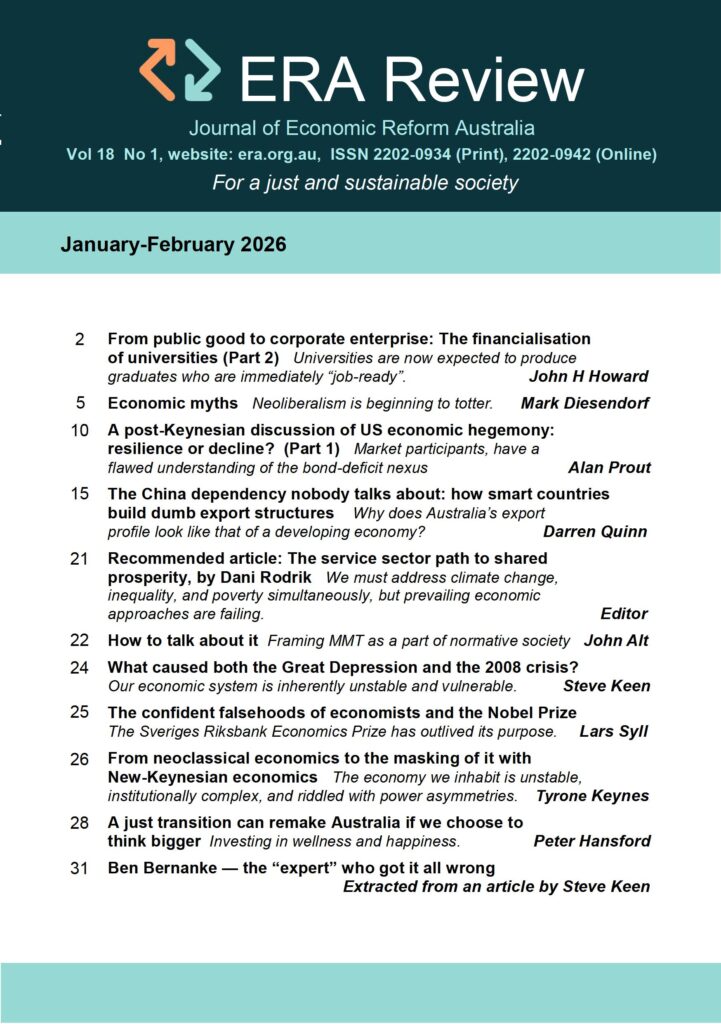What Is a steady state economy? – Editor
The following has been extracted from the website of CASSE (Center for the Advancement of the Steady State Economy):- http://www.steadystate.org/wp-content/uploads/CASSE_Brief_SSE.pdf
Sound byte
A steady state economy is a truly green economy. It aims for stable population and stable consumption of energy and materials at sustainable levels.
Definition of a steady state economy
A steady state economy features relatively stable size. It is ideally established at a size that leaves room for nature and provides high levels of human wellbeing. The term typically refers to a national economy, but it can also be applied to the economy of a city, region, or the entire planet. The size of an economy is generally determined by multiplying population by the amount that each person consumes. This quantity in a steady state economy neither grows nor contracts from year to year.
Herman Daly, the dean of ecological economics, defines a steady state economy as… “an economy with constant stocks of people and artefacts, maintained at some desired, sufficient levels by low rates of maintenance throughput, that is, by the lowest feasible flows of matter and energy from the first stage of production to the last stage of consumption.”
So a steady state economy aims for stability or mildly fluctuating levels in population and consumption of energy and materials.
To get a feel for how this works, consider a mature forest. It does not grow in size, but it is a living system with a complex web of parts.
Remarkably diverse species cooperate and compete within the forest, and new species and ecosystem functions develop over time.
Just like in the forest, stability in a steady state economy is very different from stagnation. Ecological economists actually call this kind of stability a dynamic equilibrium. This fancy term means that a steady state economy is dynamic – it changes and develops over time, but it remains balanced with the natural environment. The idea is to right-size the economy, to find the Goldilocks size that’s not too small and not too big, but just right.
Rules for a steady state economy
Good economic policies strive to achieve societal goals like sustainability and fairness with the least amount of impingement on individual freedoms.
Following this principle, achieving a steady state economy requires adherence to only four basic rules or system principles that are hard to argue with:
-
- Maintain the health of ecosystems and the life-support services they provide.
- Extract renewable resources like fish and timber at a rate no faster than they can be regenerated. (3) Consume non-renewable resources like fossil fuels and minerals at a rate no faster than they can be replaced by the discovery of renewable substitutes.
- Deposit wastes in the environment at a rate no faster than they can be safely assimilated.
Benefits of a steady state economy
A steady state economy is the only type of economy that is sustainable over the long term. It is an economy that meets people’s needs without undermining the life-support services of the planet. It represents the ultimate social movement toward a better world for all. Life is downshifted as overconsumption,
congestion, sprawl, and unfair trade practices fade away. People instead focus on community, relationships, sufficient consumption, and the things that really matter in life.
Myths and reality
Misconceptions about the steady state economy can be decisively refuted :
Myth
Reality
Failure to grow causes economic turmoil and unemployment.
Our current economy is structured for growth. When consumption slows in a growth economy, recession ensues. But a steady state economy is precisely and intentionally structured for stability. It’s the stability that provides a good life for citizens and eliminates turbulent boom/bust cycles.
A steady state economy requires a socialist regime.
Market structures are employed to allocate resources efficiently, but some vital decisions (e.g., how big to grow) are kept outside the market. A steady state economy will feature a mix of private and public ownership of economic resources.
We’ll be mired in poverty.
Economic growth has not eradicated poverty. The condition of having a stable and sustainable population in a steady state economy allows more resources per person.
Sources
Czech, B. 2006. Steady State Economy. Encyclopedia of Earth. Eds. Tom Tietenberg et al., National Council for Science and the Environment, Washington, DC.
Czech, Brian and Herman Daly. 2004. The Steady State Economy – What It Is, Entails, and Connotes. Wildlife Society Bulletin 32(2): 598-605.
Daly, Herman. 1991. Steady-State Economics. Island Press, Washington, DC. 286pp. Daly, Herman and Joshua Farley. 2003. Ecological Economics: Principles and Applications. Island Press, Washington, DC. 450pp.






























